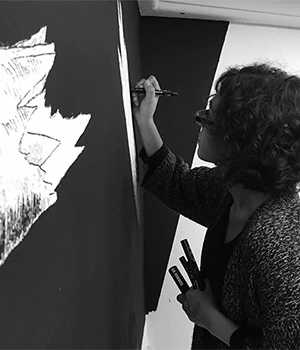
BIO
Cristina Ramírez (Toledo, 1981) studied a BA in Art History and a BA in Fine Arts at the University of Granada. She works on drawing and sculpture.
Her recent individual projects include ‘Kenophilia’ (Marta Gualda Artifacts, Charlotte, USA, 2021), ‘Mano de Hierro’ (La Carbonería, Huesca, 2020), ‘El pozo y la pirámide’, in cooperation with Álvaro Albaladejo (Fundación BilbaoArte, Bilbao, 2019) and ‘Nine Angles’ (Sala Ático, Granada, 2016).
He has also joined collective exhibitions such as ‘Error de Cálculo’ (Botí Foundation, Córdoba, 2021), ‘Arrancarse los ojos’ (La Gran Gallery, Madrid, 2020), Beltrán, Chanivet, del Castillo, de la Cruz, Montesinos and Ramírez (Creation Center Contemporary C3A, Córdoba, 2019), DKV-Makma National Drawing Award, (Museo ABC, Madrid 2019) or ‘Atavic Memory’, (Spanish Contemporary Art Network, London, 2019).
Some of the Collections holding works by Ramírez are The DKV Foundation Art Collection, the BilbaoArte Fundazioa Foundation, the SCAN Collection, the General Foundation of the Complutense University, the University of Granada, the Granada City Council or the Casa Falconieri Collection.
ARTWORK
CADY ROBERTS’S REPLY
Cristina Ramirez’s ‘Cady Roberts’s reply’ project for the first edition of DinA3 combines image, text and fiction to address landscape representation.
The proposal has its origin in the ‘creepypasta’, a horror story genre similar to an urban legend whose publication started on various Internet portals and blogs at the beginning of the 21st century. The success of this fiction genre stems from the link established between supernatural and reality and its immediacy.
Their spread through email chains lays the foundations of this contemporary folklore and consolidates the change from the oral transfer – typical of the story or legend – to the digital. These message chains tell stories that challenge us and commit us to an active response, resulting from fear and superstition. Therefore, what is fascinating about the creepypasta genre is how it influences our plane, modifies it, and, thus, how fiction leaps into the real world through a gesture. When we decide to forward the email from a chain to avoid a curse, we grant a fiction the status of reality.
‘Cady Roberts’s reply’ is a creepypasta (1). It is a short story within the framework of Internet horror fiction. Both the landscape and Cady Roberts – an American programmer who disappeared in 2009 – are starting the story that inspires the silkscreen edition.
Cristina Ramírez’s silkscreen for DinA3 deals with the idea of a ghost. Each of its three inks turns the print into an apparition. The main figure is stamped in grey on a background for which an ink known as ‘Ghost White’ (a web colour created in 1987) has been used. The combination of both inks and their particularities results in a low contrast image in which the background and the figure look fainted or revealed, depending on the environment’s light changes. The third ink is an invisible, phosphorescent material activated when the image is in a dark environment, thus making the piece shine.
‘Cady Robert’s reply’ mutability turns us into active spectators and forces us to make decisions for its observation, interweaving fiction and reality.
(1) Creepypasta is a term coined in 2006, resulting from the union of the English voice ‘creepy’ (terrifying) and the word that refers to the action of cutting and pasting information, known as ‘copypaste’. This neologism synthesizes the transmission mechanism of contemporary fiction, heir to the oral tradition folklore. Among the most popular creepypasta are ‘The Slenderman’ (2009), ‘The Russian sleep experiment’ (2010), ‘Petscop’ (2017) or ‘Ayuwoki’ (2019).


